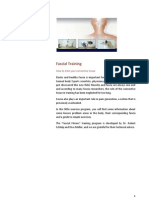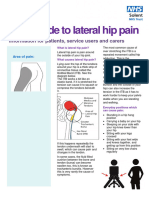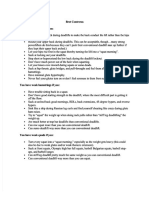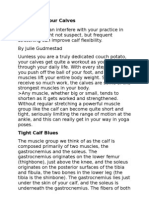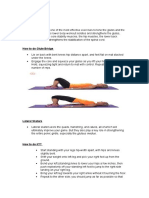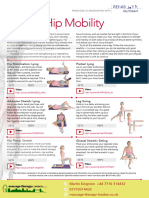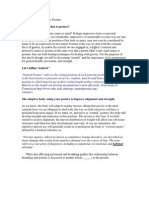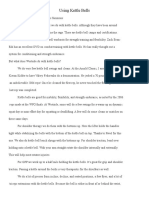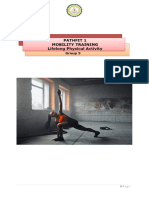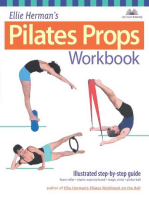Heel Strtetches
Uploaded by
hanemog681Heel Strtetches
Uploaded by
hanemog6812/1/2021 Knee Ability Zero Now Complete as a Picture-Book!
p g g , j g y p
way I have kept pushing my own body to the limit, and no matter how great I got at
the direct
Subscribe knee
Past exercises you will learn as you continue reading, I still suffered from
Issues Translate
foot pain, Achilles pain, nasty shin splints, and "mystery" lower knee pains.
I recall that at my worst, my foot and lower leg pains were so bad, I would wake up in
the morning and wonder, "Will today be a walking to the bathroom morning, or a crawl
to the bathroom morning?" Sometimes the pain was too great to bear the load on my
feet.
You see, coming from such weak knees, and then jacking up my knee strength so
greatly, I was capable of producing far more force than my lower leg muscles had
handled throughout my life. By reverse engineering this situation, I soon realized the
tibialis was the missing link in my regimen, and I was overjoyed when I found that
transforming this muscle, took my knees themselves to the next level of ability!
For example, prior to the Tibialis Raise, I had achieved the ability to dunk, but only
when I jumped off two feet. When I did a one foot jump, I got nowhere near as high,
and was prone to debilitating foot, shin, and knee pains, which prevented me from
trying. Not longer after making the Tibialis Raise a standard part of Knee Ability, I was
dunking off one foot with ease. All these lower extremity pains have disappeared, and
never come back.
If you look at your body logically, the Tibialis Raise would be the first place to start,
regardless of what physical issues you may be having.
Last tip: make sure you realize your shoes' heel height affects the difficulty of the
exercise: the higher the heel, the harder it is, and the lower the heel, the easier it is.
STEP 2: THE FHL (FLEXOR HALLUCIS LONGUS) CALF RAISE
The flexor hallucis longus is a powerful muscle which runs all the way from your big toe
to your mid-calf. It helps stabilize your ankle when weight is on the ball of your foot,
and it is particularly important when force goes through your big toe. Hallucis is a Latin
word meaning "of the big toe," so flexor hallucis longus simply means "a long muscle
that flexes your big toe."
https://mailchi.mp/284f5262674e/knee-ability-for-life-july-6056807?e=[UNIQID] 6/49
You might also like
- Structures: Highway Design Standards 2010No ratings yetStructures: Highway Design Standards 201045 pages
- ENDURANCE by Earle E. Liederman - Author and Publisher, (1926), - Chapter 14No ratings yetENDURANCE by Earle E. Liederman - Author and Publisher, (1926), - Chapter 145 pages
- Unlocking The Pelvic Floor: Restorative Exercise™ Institute (Rexi)100% (4)Unlocking The Pelvic Floor: Restorative Exercise™ Institute (Rexi)2 pages
- Journal: You Don't Know Squat Without An "Active Hip"No ratings yetJournal: You Don't Know Squat Without An "Active Hip"5 pages
- The Ultimate Hip Knee and Ankle Guide For One Legged Squats2100% (1)The Ultimate Hip Knee and Ankle Guide For One Legged Squats235 pages
- Bret Contreras Bret Contreras You Have Weak Glutes If You: You Have Weak Glutes If You100% (2)Bret Contreras Bret Contreras You Have Weak Glutes If You: You Have Weak Glutes If You4 pages
- YYEr8t4hTzmuJeSbawaA_Active_Squat_EBook_v2No ratings yetYYEr8t4hTzmuJeSbawaA_Active_Squat_EBook_v229 pages
- Screenshot 2019-10-29 at 11.49.30 PM PDFNo ratings yetScreenshot 2019-10-29 at 11.49.30 PM PDF1 page
- Hip Flexors - The Iliopsoas - Tightness or Weakness100% (1)Hip Flexors - The Iliopsoas - Tightness or Weakness4 pages
- Identifying and Correcting Thoracic Spinal Flexion in The SquatNo ratings yetIdentifying and Correcting Thoracic Spinal Flexion in The Squat4 pages
- Knee Pain and The Internal Arts: Correct Alignment (Standing)No ratings yetKnee Pain and The Internal Arts: Correct Alignment (Standing)7 pages
- An Internal Gym For Couch Potatoes Rev 4-5-2013No ratings yetAn Internal Gym For Couch Potatoes Rev 4-5-20135 pages
- 3 Fixes For Mysterious Knee, Back, and Elbow PainNo ratings yet3 Fixes For Mysterious Knee, Back, and Elbow Pain6 pages
- Think Hips! The Five Minute Hip Flexor Stretch Solution: Simple Hip Flexor Strengthening Exercises to Reduce Joint Pain & Increase Muscle Flexibility: Think Hips!, #1From EverandThink Hips! The Five Minute Hip Flexor Stretch Solution: Simple Hip Flexor Strengthening Exercises to Reduce Joint Pain & Increase Muscle Flexibility: Think Hips!, #1No ratings yet
- Improving Your Squat (Health Mates and 360 Physio)100% (1)Improving Your Squat (Health Mates and 360 Physio)11 pages
- 12 Best Hamstring Exercises For Use in Workouts For Stronger LegsNo ratings yet12 Best Hamstring Exercises For Use in Workouts For Stronger Legs1 page
- Relieve Your Low Back and Hip Pain RedefiningStrengthNo ratings yetRelieve Your Low Back and Hip Pain RedefiningStrength68 pages
- Dealing With Gravity: What Is Posture?: Connecticut HTTP://WWW - Oehc.uchc - Edu/ergo - Neutralposture - Asp)No ratings yetDealing With Gravity: What Is Posture?: Connecticut HTTP://WWW - Oehc.uchc - Edu/ergo - Neutralposture - Asp)3 pages
- Appendix 1 - Bodyweight Training Index PDF100% (3)Appendix 1 - Bodyweight Training Index PDF20 pages
- Deltoids: Military Presses (Standing or Seated)No ratings yetDeltoids: Military Presses (Standing or Seated)15 pages
- Fitness Tests Posture Tightness and SolutionsNo ratings yetFitness Tests Posture Tightness and Solutions8 pages
- Rac-Lbp Handout Back Pain With ExtensionNo ratings yetRac-Lbp Handout Back Pain With Extension2 pages
- What Causes Poor Hip Mobility & Why You're StrugglingNo ratings yetWhat Causes Poor Hip Mobility & Why You're Struggling37 pages
- The 10-Minute Joint Pain Solution: A Fast and Natural Method to Relieve Stiffness, Reduce Inflammation, and Regain MobilityFrom EverandThe 10-Minute Joint Pain Solution: A Fast and Natural Method to Relieve Stiffness, Reduce Inflammation, and Regain MobilityNo ratings yet
- Ellie Herman's Pilates Props Workbook: Illustrated Step-by-Step GuideFrom EverandEllie Herman's Pilates Props Workbook: Illustrated Step-by-Step GuideNo ratings yet
- Path Planning and Controlling of Omni-Directional Robot Using Cartesian Odometry and PID AlgorithmNo ratings yetPath Planning and Controlling of Omni-Directional Robot Using Cartesian Odometry and PID Algorithm6 pages
- Full download Tulip 1st Edition Celia Fisher pdf docx100% (11)Full download Tulip 1st Edition Celia Fisher pdf docx50 pages
- Common-Emitter Circuit With Emitter Resistor: Without RNo ratings yetCommon-Emitter Circuit With Emitter Resistor: Without R16 pages
- The Complete Book of Essential Oils and Aromatherapy, Revised and Expanded: Over 800 Natural, Nontoxic, and Fragrant Recipes To Create Health, Beauty, and Safe Home and Work EnvironmentsNo ratings yetThe Complete Book of Essential Oils and Aromatherapy, Revised and Expanded: Over 800 Natural, Nontoxic, and Fragrant Recipes To Create Health, Beauty, and Safe Home and Work Environments1 page
- School Form 3 (SF3) Books Issued and Returned For Senior High School (SF3-SHS)No ratings yetSchool Form 3 (SF3) Books Issued and Returned For Senior High School (SF3-SHS)2 pages
- The Need For Next-Generation ROADM Networks: White PaperNo ratings yetThe Need For Next-Generation ROADM Networks: White Paper15 pages
- Matalam Polytechnic Colloege, Inc. Matalam, Cotabato Table of Specification 4Th Quarter Ict Grade 11No ratings yetMatalam Polytechnic Colloege, Inc. Matalam, Cotabato Table of Specification 4Th Quarter Ict Grade 114 pages
- Magic Forest Academy-Nature Journal Prompts100% (4)Magic Forest Academy-Nature Journal Prompts15 pages
- Puskesmas: Modo Kecamatan: Bukal Kab/Kota: Buol Propinsi: Sulawesi Tengah Bulan: JanuariNo ratings yetPuskesmas: Modo Kecamatan: Bukal Kab/Kota: Buol Propinsi: Sulawesi Tengah Bulan: Januari42 pages






